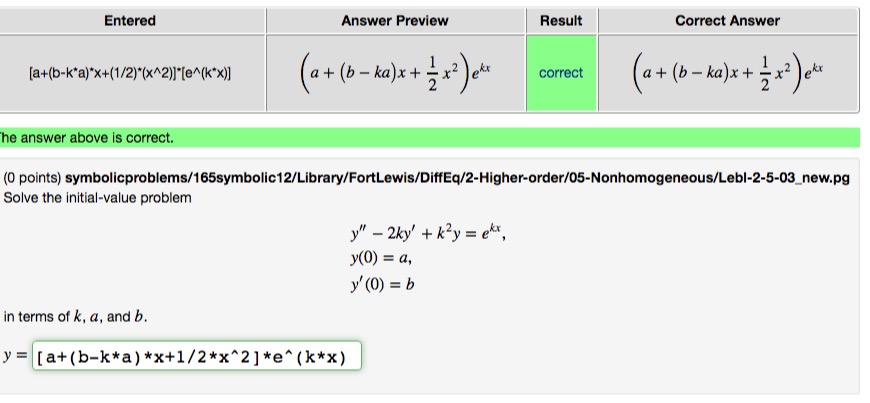A collage in ECE would like to ask the students to derive the differential equation for a simple circuit. The usual answer for this is something like that in the attached file. Is there a way the students can enter derivatives or indefinite integrals in their answer - such a way that it can be checked?
You could easily check the last question (with the values in the box). We've had good luck checking purely symbolic (but more math related) questions which could probably handle questions b -- d. (see image attached)
Possibly even question (a) could be handled but I would suggest that might be better suited to an essay question to be graded by hand.
(see essay questions: http://webwork.maa.org/wiki/Essay_Questions )

I could handle all the symbolic variables except the operators. image attached. How do I insert images into the message window?
the code is
DOCUMENT();
loadMacros(
"PGstandard.pl",
"MathObjects.pl",
"AnswerFormatHelp.pl",
"answerHints.pl",
"parserFunction.pl",
"PGcourse.pl",
"PG.pl",
);
TEXT(beginproblem());
#############################
# Setup
## required to use step function
Context("Complex")->functions->add(
step => {
class => 'Parser::Legacy::Numeric',
perl => 'Parser::Legacy::Numeric::do_step'
},
);
Context()->variables->add(
t=>"Real", C=>"Real", L=>"Real", R=>"Real", I=>"Real", Vs=>"Real", w=>"Real",
V0=>"Real"
);
# Change tolerance to account for difference in Matlab and Webwork computations
# I don't know the problem yet
Context()->flags->set(
tolerance => 0.001,
tolType => "absolute",
);
parserFunction("u(t)" => "step(t)");
$answer[0] = Formula("L")->reduce;
$answer[1] = Formula("1/C")->reduce;
$answer[2] = Formula("R")->reduce;
$answer[3] = Formula("R*I + j*w*L*I - j*I/(w*C)")->reduce;
$answer[4] = Formula("V0*exp(j*pi/3)")->reduce;
$answer[5] = Formula("V0*exp(j*pi/3)/(R + j*w*L - j/(w*C))")->reduce;
#############################
# Main text
Context()->texStrings;
BEGIN_TEXT
This is a test problem
$PAR
\{image("RLC_Series_Circuit.png",height=>140, width=>270)\} $BR
Problem is related to Problem x.xx in the text (for ECE303).
$PAR
$PAR For the above circuit, with \( v_s(t) = V_0 cos(\omega t + \pi/3) \) Volts, write the voltage loop equation in terms of the current \(i(t)\), using the symbolic values \( R\), \( L\), \( C\), \( v_s(t)\).
$BR
\(\Large{ v_s(t) = }\) \{ ans_rule(10) \}\( \Large{ \frac{di(t)}{dt} } \) + \{ ans_rule(10) \}\( \Large{ \int i(t) dt } \) + \{ ans_rule(10) \}\( \Large{ i(t) } \)
\{ AnswerFormatHelp("formulas") \}
$PAR Write the corresponding phasor-domain equation. Use upper case I for the phasor current \(\tilde{I}\) and \(w\) for the frequency \(\omega\).
$BR
\( Vs = \) \{ ans_rule(40) \}
\{ AnswerFormatHelp("formulas") \}
$PAR Write the phasor representation of the voltage source \( v_s(t) = V_0 cos(\omega t + \pi/3) \) Use Vs for the phasor \(\tilde{V}_s\)
$BR
\( Vs = \) \{ ans_rule(40) \}
\{ AnswerFormatHelp("formulas") \}
$PAR Using the phasor representation of the voltage source, solve the phasor equation to obtain an expression for the phasor current, I.
$BR
\( I = \) \{ ans_rule(40) \}
\{ AnswerFormatHelp("formulas") \}
END_TEXT
Context()->normalStrings;
############################
# Answers
$showPartialCorrectAnswers = 1;
ANS( $answer[0]->cmp() );
ANS( $answer[1]->cmp() );
ANS( $answer[2]->cmp() );
ANS( $answer[3]->cmp() );
ANS( $answer[4]->cmp() );
ANS( $answer[5]->cmp() );
COMMENT("MathObject version.");
SOLUTION(EV3(<<'END_SOLUTION'));
END_SOLUTION
ENDDOCUMENT();
It should be possible to enter formulas containing first derivatives, at least, by declaring "dy" and "dx" (and so on) to be variables.